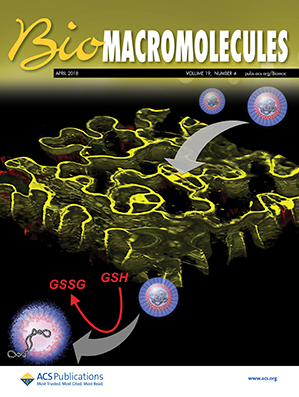以 NHC 为基础的锌络合物促进环状碳酸酯的开环聚合,从而制备二氧化碳基聚碳酸酯。
IF 5.4
2区 化学
Q1 BIOCHEMISTRY & MOLECULAR BIOLOGY
引用次数: 0
摘要
研究表明,骨架取代的 N-杂环碳烯(NHC)锌络合物与醇类引发剂相结合,可有效催化碳酸三亚甲基酯(TMC)的开环聚合反应(ROP),生成无氧杂环丁烷连接的聚(碳酸三亚甲基酯)(PTMC)。TMC 的 ROP 在溶液中进行,生成的 PTMC 具有可控的分子质量(2500 < Mn < 10000)和低分散性(Đ∼ 1.2)。通过改变醇类引发剂,得到了具有不同端基的 PTMC,其中包括一种远切聚合物。MALDI-ToF 和 NMR 分析结果证实了本 ROP 催化体系的可控性/活体性,在聚合过程中,副反应(如分子间和分子内酯化)被降至最低。在不同溶剂中进行的溶液研究表明,聚合反应是通过单体和催化剂的一阶机制进行的。锌复合物还能转化取代的环状碳酸盐,这些碳酸盐是特意从二氧化碳和 1,3 二醇等可再生原料中合成的。对于不对称的 2-Me TMC 单体,观察到了良好的区域选择性(Xreg 高达 0.92)。通过使用聚乙二醇(PEG)作为大引发剂制备聚碳酸酯/聚醚三嵌段共聚物,以及通过 TMC 和 L-LA 的连续 ROP 制备定义明确的二嵌段和三嵌段聚碳酸酯/聚乳酸共聚物,聚合过程的良好控制最终得以体现。本文章由计算机程序翻译,如有差异,请以英文原文为准。


CO2‑Based Polycarbonates through Ring-Opening Polymerization of Cyclic Carbonates Promoted by a NHC-Based Zinc Complex
A backbone-substituted N-heterocyclic carbene (NHC) zinc complex, in combination with alcohol initiators, has been shown to be an effective catalyst for the ring-opening polymerization (ROP) of trimethylene carbonate (TMC) to poly(trimethylene carbonate) (PTMC) devoid of oxetane linkages. The ROP of TMC proceeded in solution to give PTMC, possessing controlled molecular mass (2500 < M n < 10000) and low dispersity (Đ ∼ 1.2). Changing the alcohol initiators, PTMCs with different end-groups were obtained, included a telechelic polymer. The results of MALDI-ToF and NMR analysis confirmed the controlled/living nature of the present ROP catalytic system, where side reactions, such as inter- and intramolecular transesterifications, were minimized during the polymerization. Solution studies in different solvents demonstrated the polymerization reaction to proceed via a mechanism first order in monomer and in catalyst. The zinc complex was also able to convert substituted cyclic carbonates, which were purposely synthesized from renewable feedstocks such as CO2 and 1,3-diols. For the asymmetric 2-Me TMC monomer, good regioselectivity was observed (X reg up to 0.92). The excellent control of the polymerization process was finally brought to light through the preparation of polycarbonate/polyether triblock copolymers by using polyethylene glycol (PEG) as a macroinitiator and of well-defined di- and triblock polycarbonate/polylactide copolymers by sequential ROP of TMC and L-LA.
- Download: Download high-res image (44KB)
- Download: Download full-size image
求助全文
通过发布文献求助,成功后即可免费获取论文全文。
去求助
来源期刊

Biomacromolecules
化学-高分子科学
CiteScore
10.60
自引率
4.80%
发文量
417
审稿时长
1.6 months
期刊介绍:
Biomacromolecules is a leading forum for the dissemination of cutting-edge research at the interface of polymer science and biology. Submissions to Biomacromolecules should contain strong elements of innovation in terms of macromolecular design, synthesis and characterization, or in the application of polymer materials to biology and medicine.
Topics covered by Biomacromolecules include, but are not exclusively limited to: sustainable polymers, polymers based on natural and renewable resources, degradable polymers, polymer conjugates, polymeric drugs, polymers in biocatalysis, biomacromolecular assembly, biomimetic polymers, polymer-biomineral hybrids, biomimetic-polymer processing, polymer recycling, bioactive polymer surfaces, original polymer design for biomedical applications such as immunotherapy, drug delivery, gene delivery, antimicrobial applications, diagnostic imaging and biosensing, polymers in tissue engineering and regenerative medicine, polymeric scaffolds and hydrogels for cell culture and delivery.
 求助内容:
求助内容: 应助结果提醒方式:
应助结果提醒方式:


